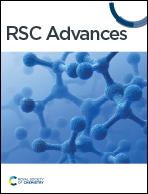High-performance self-powered ultraviolet photodetector based on a ZnO/CuPc inorganic/organic heterojunction
Abstract
A self-powered photodetector (PD) based on n-type ZnO/p-type small-molecule copper(II) phthalocyanine (CuPc) inorganic/organic heterojunction film deposited on FTO substrate was constructed by simple solution spin-coating and thermal evaporation technology. The designed heterojunction device exhibits typical photoresponse behavior under zero bias, indicating that the device possesses a self-powered characteristic. This may benefit from the formation of a built-in electric field in the heterojunction, which can effectively separate electron–hole pairs. Specifically, the optimal performances of the device appear at a wavelength of 365 nm and light intensity of 0.03 mW cm−2, achieving on/off ratio of ∼245.88 (29.88), responsivity (Rp) of ∼227.11 mA W−1 (0.39 mA W−1), detectivity (D*) of ∼7.63 × 1011 Jones (∼7.53 × 109 Jones) and EQE of ∼77.23% (0.14%) at +2 V (0 V) bias voltage. In addition, the device has potential application in weak light detection. Therefore, the construction of inorganic/organic heterojunctions may provide a feasible strategy for the development of high-performance, self-powered and wavelength-selective PDs.



 Please wait while we load your content...
Please wait while we load your content...